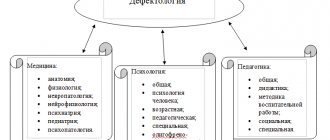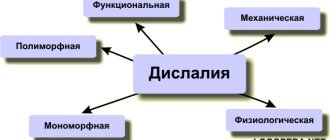Rhetoric as science and art
The rhetoric of speech arose in ancient times and at the same time two of its directions emerged:
- rhetoric as the science of demonstrative speech;
- rhetoric as the art of eloquence.
The definition of modern rhetoric brings these divergent views together:
The subject of its study is speech, which can be convincing and beautiful, influencing the listener and delivering aesthetic pleasure.
Rhetoric as a science teaches the rules of its construction, organization of communication, creation and expression of one’s thoughts in words. Rhetoric as an art deals with developing the skills to speak and write beautifully, to master words perfectly, and to arouse reciprocal interest in the listener.
Rhetoric
The concept of rhetoric as a science. Subject and tasks of rhetoric
The terms “rhetoric” (Greek rhetorike), “oratory” (Latin oratorare - “to speak”), “oratory” (obsolete, Old Church Slavonic), “eloquence” (Russian) are synonymous.
In the ancient understanding, rhetoric is eloquence, the theory of eloquence, the science of oratory. Rhetoric arose in Greece in the 5th century BC and developed into a system in the 3rd–2nd centuries. BC. and received its development in Rome in the 1st century. BC. The basis of rhetoric is considered to be the foundations of such sciences as philosophy, logic, pedagogy, linguistics, psychology, ethics and aesthetics. With the development of these sciences, the idea of rhetoric also changed. In ancient Greece, rhetoric was defined as the art of persuading listeners. In Rome - as the art of speaking well and beautifully (ars bene dicendi). In the Middle Ages, rhetoric was considered as the art of decorating oral and written speech (ars ornandi). Russian rhetorical science traces the ancient Greek tradition of defining rhetoric as the art of persuasion.
The goals of rhetoric also changed. Ancient rhetoric was born from the practice of socio-political and judicial speeches. In the Middle Ages, rhetoric was focused on writing letters and religious sermons. During the Renaissance, it spread to the entire field of literary prose, became part of humanities education, and mastery of the basics of eloquence was considered a sign of high education and culture.
Currently, the term “rhetoric” is used in a narrow and broad sense. In a narrow sense, rhetoric is an applied linguistic science that studies the patterns of speech, with the goal of teaching people to speak language easily and beautifully. The linguistic dictionary defines rhetoric as a philological discipline that studies methods of constructing artistically expressive speech.
Rhetoric in a broad sense is called neo-rhetoric (the term was introduced by Brussels University professor H. Perelman in 1958) or general rhetoric. Its development is caused by the emergence of new linguistic sciences - text linguistics, semiotics, hermeneutics, theory of speech activity, psycholinguistics. Neorhetorics is looking for ways to practically apply these disciplines; it is being developed at the intersection of linguistics, literary theory, logic, philosophy, ethics, aesthetics, and psychology.
In the theory of modern eloquence, the ancient original core is revived - the concept of persuasion, forms and methods of influence by means of oral and written speech are considered. The goal of the updated rhetoric is to determine the best options, optimal communication algorithms. For example, the roles of participants in dialogue, mechanisms of speech generation, language preferences of speakers, etc. are studied. Thus, neo-rhetoric is the science of persuasive communication.
So, the term “rhetoric” includes the concepts of “eloquence”, “skill of public speaking” and “oratory”. If eloquence means the ability to speak captivatingly, beautifully, and convincingly, then the skill of public speaking is a higher level, which presupposes, along with the ability to speak beautifully and convincingly, the ability to master the communication situation, knowledge of the psychology and sociology of the audience, etc.
Rhetoric taught and teaches how to communicate, logically and expressively present and develop thoughts, use words, how to use speech activity in personal life and public activities, how to speak in front of an audience. The theory of eloquence has always paid primary attention to oral, “live” contact.
Rhetoric as a science performs the following tasks:
1) search for optimal algorithms for communication and mutual understanding in the conditions of modern society;
2) study of the forms and mechanisms of speech;
3) formation of a linguistic personality;
4) improving speech culture;
5) improving speech self-expression;
6) modeling of communication processes.
Fundamentals of Rhetoric
Rhetoric will tell you everything about public speech, its stages, goals, sources of material, methods of presentation, means of speech influence, as well as the requirements for the speaker’s personality.
Today, the ability to competently build communication is a necessary condition for success in the social life of every person. For those who are directly involved in speaking in front of an audience, this skill is the key to professional excellence.
Let's find out what an effective public speech should be.
The speaker’s speech will be successful if it organically combines logic and emotionality, information content and expressiveness. It is good if it is not read, but pronounced in the form of live communication with listeners.
Types of rhetoric
Currently, there is the following classification of rhetoric by type:
- socio-political (parliamentary and rally speeches, campaign speeches), which is characterized by emotionality, and often pathos, for persuasion and motivation to action;
- academic (scientific review, educational lecture), with arguments and facts, structured, sometimes monotonous and indifferent, as soon as the speaker loses touch with the audience, reading a prepared text;
- social and everyday (welcome, table, anniversary address, toast), for the most part simple and sincere, not distinguished by perfect logic and clear structure, but sincere and kind-hearted;
- judicial (accusatory, defensive), strictly reasoned and balanced, determining the fate of a person;
- theological-church (sermon, official church speech) uplifting spiritually, bringing joy, instructing for good;
- military (address-order, instructive, inspiring speech), specific, strict, strengthening patriotic feelings, nurturing love for the Fatherland;
- diplomatic (speech at international negotiations and conferences), characterized by a high degree of responsibility for every word spoken;
- business (business as well as telephone conversations), the obligatory elements of which are accessibility, expressiveness, and literacy;
- dialogical (interview, argument, discussion), which requires practicing the skills of proper dialogue.
Main types of eloquence
For each of the life types, a certain type of science of eloquence is suitable for study:
- Socio-political. This type emphasizes the ability to speak at rallies, political debates, and delivering reports for the economic and political sectors.
- Scientific. Useful for delivering reports and lectures, for making effective and memorable speeches.
- Judicial. A separate category that has found its application specifically for the performance of lawyers and jurists during legal proceedings in order to be able to effectively apply arguments and accusations.
- The social and everyday area will allow you to effectively use your speech for speeches during the celebration.
- Church. It is useful for general church ministers and is necessary for maintaining a high-level conversation during church councils.
- The ability to give clear and undeniable orders is useful in the military.
- Pedagogical will be useful for teachers and professors when communicating with students.
New species require special attention, and more and more of them appear every year. So dialogues with yourself will allow you to correctly express your own thoughts for the success of your business.
The connection between rhetoric and other humanities
Rhetoric is a philological science. But being a multifaceted teaching, it is closely intertwined with a variety of areas of knowledge related to the effectiveness of communication, and also uses methods of non-speech sciences.
Rhetoric is associated with:
- logic - the science of correct thinking;
- grammar, which studies the rules of speech;
- poetics - the study of the means and techniques of artistic expression;
- a culture of speech that obliges us to comply with the norms of the literary language;
- stylistics, which studies the patterns of language functioning in the process of speech communication.
The use of psychological methods makes it possible to explain human behavior and understand his state of mind.
The connection between rhetoric and ethics provides knowledge of the laws of morality and morality of society. The union of rhetoric and philosophy allows us to raise the solution of any problem to a higher moral and spiritual level.
The concept of “speech” in the theory and practice of sciences
Mishina G.A., Chernichkina Yu.D.
Modern trends are such that a scientific problem is considered from the perspective of different branches of scientific knowledge. This leads to the emergence of new sciences, as if “at the junction” of existing ones. In relation to speech, these include psycholinguistics (C. Osgood, Pierce, T. Sibeok, A.A. Leontyev, I.N. Gorelov, A.A. Zalevskaya, N.I. Lepskaya, etc.), psychosemiotics (M V. Gamezo, V. F. Rubakhin, E. I. Isenina, etc.), neurolinguistics (A. R. Luria), linguopsychology (I. A. Zimnyaya), ontopsycholinguistics (M. Tomasello, E. Bates), neuropsycholinguistics (K.F. Sedov), neuropsychoparalinguistics (E.N. Vinarskaya), logopathology (A.N. Kornev), etc. On the one hand, this allows us to consider the phenomenon being studied holistically with the use of evidence obtained in other sciences, seeing the place this phenomenon in the overall picture. However, on the other hand, the terms of one science are borrowed by another, reinterpreted, supplemented, and their “erosion” is observed.
The enduring importance of speech in phylo- and sociogenesis, the variety of functions it performs, the multidimensionality of speech as an object of study, various technical capabilities (for example, computer analysis) for processing the data obtained still contribute to maintaining great interest in this problem among scientists from various scientific fields. An analysis of the literature has shown that in many scientific works, domestic authors use the terms “language”, “speech”, “speech activity” as synonyms, interchanging each other.
A significant amount of research devoted to speech in various sciences - philosophy (E. Condillac, P.V. Kopnin, M.S. Kozlova, etc.), linguistics (A.N. Gvozdev, S.N. Tseitlin, E.S. Kubryakova, N.M. Yuryeva, etc.), psychophysiology (A.G. Ivanov-Smolensky, M.M. Koltsova, N.I. Krasnogorsky, I.P. Pavlov, P.K. Anokhin, L.A. Chistovich and others), psychology (L.S. Vygotsky, K. Buhler, A.V. Zaporozhets, N.I. Zhinkin, T.E. Konnikova, M.I. Lisina, M.G. Elagina, S. L.V. Kornitskaya, S.Yu. Meshcheryakova, G.M. Lyamina, V.I. Lubovsky, A.K. Markova, N.A. Menchinskaya, L.F. Obukhova, S.L. Rubinstein; J. Piaget , N.H. Shvachkin, etc.), psycholinguistics (T.V. Bazzhina, I.N. Gorelov, I.A. Zimnyaya, A.A. Leontyev, N.I. Lepskaya; T.N. Ushakova, PM Frumkin, A.M. Shakhnarovich and others), paralinguistics (G.V. Kolshansky), semiotics and psychosemiotics (A.A. Vetrov, E.I. Isenina, E.E. Sapogova, N.G. Salmina), neuropsychology (T.V. Akhutina, A.R. Luria, E.D. Khomskaya, L.S. Tsvetkova, A.V. Semenovich), speech therapy (R.E. Levina, M.E. Khvattsev, L.S. Volkova, G.V. Chirkina, V.A. Kovshikov, V.P. Glukhov, A.N. Kornev, etc.), etc. - showed that today there is no single definition of such a concept as “speech”. In some works (G.M. Andreeva, G.V. Kolshansky, R. Yakobson, Kodzasov, Krivnova, V.I. Postovalova) speech is synonymous with the concept of “language”, in others it is considered “as part of a broader concept - language. At the same time, language means an instrument (means) of communication, and speech is the type of communication produced by this instrument (Linguistic Encyclopedic Dictionary), thirdly, on the contrary, “speech contains language as one of its sides” (A.A. Vetrov). There is no unity among psychologists either. Thus, speech is understood both as a means of communication (M.I. Lisina, M.G. Elagina, S.V. Kornitskaya, S.Yu. Meshcheryakova, etc.), and as a form of communication between people through language (V.P. Zinchenko , B.G. Meshcheryakov), both as an independent activity (A.N. Leontiev, A.A. Leontiev), and as a psychological process of formulating and transmitting thoughts through language (A.R. Luria).
In linguistic, psycholinguistic and psychophysiological works of recent years (2000–2010) devoted to speech ontogenesis, a number of authors point to the close relationship between speech and language, designating processes, functions and mechanisms as speech-linguistic (T.N. Ushakova, 2008), with this subject research becomes a “psychological component”, observed from the first days of life even in the cry (T.N. Ushakova, 2008).
The concepts of “speech” and “language” were most clearly separated initially in linguistics (language was considered as a set of phonetic, lexical and grammatical means). The Swiss linguist F. de Saussure defined language, different from speech, as the basis for its mastery. There was also an undoubted indication of the close relationship (not interchangeability!), the dichotomy of speech and language: language is a system of signs, and speech is a process, “the act of individual use of language” (I.A. Zimnyaya, 2001).
I.A. was very close to this understanding of a language “consisting of random symbols connected in the most varied ways” (i.e., a system of signs). Baudouin de Courtenay (A.A. Leontiev, 2003). However, the scientist’s contribution is that he formulated the position on the need to distinguish between the unconscious flow and conscious regulation of language processes (L.V. Shcherba). Thus, we can observe attempts to highlight in the holistic process of speaking, on the one hand, the very system of signs (and rules, and patterns of its development and functioning), on the other, the conscious regulation of “linguistic life” (A.A. Leontyev, 2003). Essentially we are talking about language and speech competence. The continuation of this direction was observed in the works of L.V. Shcherby (they were allocated speech organization, language system and language material).
Modern linguistics, based on the understanding of language as “a complex system of codes denoting objects, signs, actions or relationships that carry the function of encoding, transmitting information and introducing it into various systems” (A.R. Luria), as well as “a set of linguistic units of different ranks (sounds, morphemes, words, sentences), rules for their construction and use (S.N. Tseitlin, 2000), “...systems of existing, socially assigned signs that correlate conceptual content and typical sound, as well as systems of rules for their use and compatibility..." (G.V. Chirkina), as "a form of existence of knowledge in the form of a system of signs" (N.G. Salmina, 1988), gradually changes the subject of her science, considering linguistic means in relation to the system of meanings in the process of verbal communication ( A.A. Leontyev, 2003). Hence, in modern linguistics two approaches are distinguished - linguistic, i.e. a structural-functional way of studying language as a system, including its different levels (phonetic, morphological, etc.) (O.S. Akhmanova) and a semiotic approach - as an orientation towards studying the connection between sign and meaning, highlighting the syntactic, semantic and paradigmatic levels (Y.S. Stepanov, E.I. Isenina, M. Halliday, etc.). Moreover, linguistic signs are only one of the classes of signs (N.G. Salmina, 1988).
The concept of “speech” is not so clearly presented in the literature. For a very short period in Russian science (psychology), speech was considered as a mental phenomenon, as an independent higher mental function, as a cultural form of behavior (L.S. Vygotsky), as “a form of existence of consciousness (thoughts, feelings, experiences) for another, serving as a means communication with him, and the form of a generalized reflection of reality" (S.L. Rubinshtein), "a peculiar, specific human way of forming and formulating thoughts through language" (A.N. Leontyev), as "... one of the forms of human communication that ensures formation, transmission and perception of information..." (L.A. Orbeli).
In the early works of S.L. Rubinstein considered speech as “language functioning in the context of individual consciousness,” while he pointed out that speech is not identical to language “just as individual consciousness is different from social consciousness, psychology from ideology...”. Later, speech was presented by him as “a means of conscious influence and communication carried out on the basis of the semantic content of speech.” According to S.L. Rubinstein, speech can become conscious only if the speaker understands the purpose. Attention should be paid to the indication that speech exists only where there is semantics, meaning, having a material carrier in the form of sound, gesture, visual image, etc. Considering the relationship between thinking and speech (which was the subject of many works by both domestic and foreign researchers), Rubinstein was of the opinion that it is unlawful to reduce thinking to speech, recognizing the leading position behind thinking.
Further development of the psychological approach to understanding speech was associated with the works of I.P. Pavlov: “speech, being a means of communication, becomes at the same time a means of in-depth analysis and synthesis of reality, and, most importantly, the “highest regulator of behavior.” Taking this approach into account, A.R. Luria pointed out the enormous role of speech in the formation of mental processes.
A fairly extensive experimental study of speech as a means of communication was carried out in the context of the concept of the genesis of communication as a communicative activity (M.I. Lisina, V.V. Vetrova, D.B. Godovikova, A.K. Markova, etc.).
In our opinion, the approach of D.B. is also interesting. Elkonin (1958) to this process: “the intensive development of speech at an early age indicates that speech should be considered not as a function, but as a special object that the child masters in the same way as he masters other tools (spoon, pencil, etc. ). The development of speech is a “twig” in the development of independent objective activity. And in many ways this development depends on the conditions in which the child is raised.”
However, speech as a psychological concept was presented most holistically in the theories of L.S. Vygotsky and J. Piaget. L.S. Vygotsky considered speech in the context of the concept of “higher mental function.” Dividing mental functions into natural and cultural, L.S. Vygotsky called natural mental processes that are carried out without mediation by signs, and higher mental functions are those that are carried out thanks to auxiliary means. HMFs represent the active form of personality in its manifestations. The problem of HMF is considered in cultural-historical theory precisely as a higher form of behavior, differing from elementary behavior by the creation and use of artificial stimuli as aids for mastering one’s own reactions. “In infancy, the genetic roots of two main cultural forms of behavior are laid - the use of tools and human speech.” Mediation is “the basis of the analogy between a sign and a tool,” the common point that unites these forms. And the main “point of divergence” (L.S. Vygotsky) is their direction: the tool is “directed outward”, it is a means of external activity... (causing changes in the object), and the sign is directed inward, it is “a means of psychological influence on someone else’s behavior or your own, a means of internal activity” (G.G. Kravtsov). “The initial unit of analysis when considering the problem of mediation is an action, determined by its goal and method, consisting of operations and the corresponding tools” (G.G. Kravtsov). A.N. Leontyev O.
The formation of a reflex mechanism, on the one hand, and social life and interaction of people, on the other, are necessary conditions for the formation of cultural functions. Natural mental processes are characterized by a temporary connection that is established due to the coincidence of two stimuli that simultaneously affect the body. For cultural people, it is a temporary connection that is created by the person himself using an artificial combination of stimuli. Among all social communication systems, speech is central. At the same time, like any system, it goes through such stages in formation as interpsychological - a collective form of behavior and intrapsychological - an individual form of behavior.
In connection with the development of the activity approach in Russian psychology (A.N. Leontiev), initially in the works of N.I. Zhinkin, and then A.A. Leontief speech began to be viewed precisely as a speech activity, which had both target, motivational, and executive aspects (like any other activity). This made it possible to talk about “speech activity” (L.V. Shcherba, A.A. Leontyev) as “a special case of sign activity”, as “human activity (behavior), to one degree or another mediated by the signs of language” (A.A. . Leontiev, 2003), in which “the means (language system) and the method (speech) of forming and formulating a thought, which serves as the subject of speech activity, are highlighted” (I.A. Zimnyaya, 2001). Speech within the framework of this concept is understood as “the process of generating and perceiving speech utterances... a set of ways of carrying out speech activity” (V.A. Kovshikov, V.P. Glukhov, 2007).
Various features underlie numerous classifications of forms and types of speech (external oral (including dialogical, monological and polylogical forms), external written and internal speech; autonomous, egocentric, internal speech; expressive and impressive forms; manual and automated; situational, contextual and non-situational; rational and emotional; everyday, business, etc.). Modern psycholinguists in all these cases consider speech as “a type of implementation of speech activity” (V.A. Kovshikov, V.P. Glukhov, 2007). However, A.A. Leontyev pointed out later that “strictly speaking, speech activity as such does not exist. There is only a system of speech actions included in some kind of activity - entirely theoretical, intellectual or partially practical. A person has nothing to do with speech alone: it is not an end in itself, but a means, an instrument, although it can be used differently in different types of activity...” (2003).
In modern foreign literature, there are two terms to refer to the phenomena highlighted above - the terms “speech” (“speech”) and “language” (“language”). This division is associated with the theoretical approach of N. Chomsky, in the grammatical model of which a distinction is made between language ability (the ability to speak) and language activity (statements of a native speaker). Hence, the term “speech” refers to the physical process of speaking, by which we voice the language, including articulation, voice and fluency: “speech is a material physical process, the result of which are the sounds of speech” (D. Slobin). The term “language” means understanding others and the ability to express what we want, using words and sentences for communication, understanding oral and written text, pragmatics, morphology, grammar, word formation, phrase construction: “language is an abstract system of meanings and linguistic structures” (D. Slobin).
Huge experimental material collected by foreign (primarily American, English and partly German) linguists and psycholinguists is presented by research precisely within the framework of the concept of “language”: the model of language acquisition (N. Chomsky, H. Gardner, E. Bates, etc.) , theories of acquisition of phonology (D. Olmsted, R. Jacobson, D. Ingram, C. Ferguson, etc.), vocabulary (J. Fodor, E. Bates, D. Thal, V. Marchman, etc.), grammar (N. Chomsky , J. Bruner, D. Slobin, etc.), etc. A lot of research in line with foreign psycholinguistics has been carried out in connection with the study of the role of language in intellectual development.
Most modern foreign authors define the concept of “language” as a code for representing thought using a system of arbitrary signals in the process of communication. Moreover, this concept includes such blocks as “content” (i.e. what is being said or how the statement is understood), “form” (intonation, consistency in the statement) and “use” (motive of speaking) (L. Bloom, M .Lahey, 2000). We see that the content of this concept is quite close to the content of the domestic concepts “language”, “speech”, “speech activity”. However, the term “language” is translated from the English term “language,” which creates confusion in understanding the available foreign materials. This is important to understand because... at the present stage, domestic specialists, having wide access to English-language literature, conduct similar experimental studies on Russian-language material, using original terms, or putting similar content into the concept of “speech”.
Due to the fact that we are interested in the period from birth, which many call “pre-speech,” let us analyze the current situation. Based on the above-mentioned definition of “speech activity,” it turns out that this term can only be applied to the period when any linguistic means are formed and thought appears, i.e. after about two years (when the “crossover” of speech and thinking occurs according to Vygotsky). But how can we designate the processes observed in the first year of life and partly at an early age? Most researchers use the terms “speech development, prerequisites for speech, ontogenesis of speech, pre-speech period, early childhood speech, etc.”; in cases of dysontogenesis, the term “speech” is used mainly (including understanding, vocal production, and pragmatic aspects of communication , and the volume of the dictionary - delayed speech development, absence of speech, speech disorders, deviations in speech development (L.S. Volkova, R.I. Lalaeva, G.V. Chirkina, etc.)). Only some authors propose the term “speech-language” ability (T.N. Ushakova, 2008), or “initial stage of language development” (T.V. Bazzhina), or “protolanguage” (E.I. Isenina), or “disharmonious pathological development of the functional system of language and speech" (A.N. Kornev, 2006).
conclusions
- Currently, when researchers say “speech,” they mean speech activity, which includes speech actions (with a “signified” - the subject of the utterance - and a “signifier” - the linguistic form of expression) and operations (comparison, selection of linguistic and semantic elements, substitutions and etc.) (I.A. Zimnyaya, A.A. Leontyev). That. speech activity is presented as a broader concept, including both “speech” and “language” (linguistic abilities), as a whole and parts (A.A. Zalevskaya, I.A. Zimnyaya, A.M. Shakhnarovich, etc. ).
- Theoretical analysis allows us to say that today the issue of the content of the concept “speech” has not been resolved. Firstly, the status of speech is not defined (from a psychological position) - property, process, independent activity, communication activity, form of communication, means, etc. Secondly, following from the first as a consequence, the content of this concept depends on the approach within which it is considered.
- Recently, a fairly large number of indications and references in literary sources have appeared on the presence of phenomena of two kinds observed in the initial period (“pre-verbal”) development:
- preference for a biological basis for language and a social basis for speech;
— by examining the screaming stage, it can clearly be shown that linguistic and communicative competence arise separately” (T.V. Bazzhina, 2008);
— “it would be advisable to have two “sciences of sounds,” one of which would be oriented toward speech, the other toward language” (N.S. Trubetskoy);
— “a cry represents a two-way unity of external sound manifestation and hidden mental subjective content” (T.N. Ushakova, 2008);
- “babble can be different - for oneself and for others” (S.N. Tseitlin, 2000);
- a well-known phenomenon in linguistics: in the semantic design of an utterance, the formation proceeds from “large” units to “small” ones, and in the sound form – from “small” to “large”;
- “lexical explosion” is observed only in expressive speech; in impressive speech, accumulation proceeds smoothly (S.N. Tseitlin, 2000);
- “much more significant from the psychological side is K. Bühler’s distinction between sympractic and symphysical speech (Male and Marken). Sympraxic speech is speech woven into a non-speech situation; symphysical - speech acting as a sign of a thing” (Leontyev A.A.).
- In the context of cultural-historical theory, it is with the help of speech that natural mental functions become higher. However, the question arises in what period and how it does this.
To answer the questions posed, it is necessary to determine the psychological status of speech and carefully study the genesis of its formation.
Literature
1. Vygotsky L.S. Psychology. – M., 2000
2. Kovshikov V.A. Psycholinguistics. Theory of speech activity/V.A. Kovshikov, V.P. Glukhov. – M., 2007
3. Kornev A.N. Fundamentals of speech pathology in childhood: clinical and psychological aspects. – St. Petersburg, 2006
4. Kravtsov G.G. The problem of mediation in personality psychology/School L.S. Vygotsky today / Rep. ed. V.T. Kudryavtsev. M.: RSUH, 2005.
5. Leontyev A.A. Fundamentals of psycholinguistics - M.; St. Petersburg, 2003
6.Child’s speech: Problems and solutions/Ed. T.N. Ushakova. – M. 2008
7. Salmina N.G. Sign and symbol in teaching. – M., 1988
8. Tseitlin S.N. Language and the child: Linguistics of children's speech. – M., 2000
9. Elkonin D.B. Speech development in preschool age. – M., 1958
10.Bloom L., Lahey M. Language Development and Language Disoders. -NY, London, 2000
Development of rhetoric
How can one learn all the intricacies of this science? If you really want this, use our recommendations:
- Hone your diction. Speak slowly, pronouncing each word clearly, observe pauses and even breathing.
- Read aloud and retell what you read. Try to convey the meaning in your own words, constructing your speech yourself.
- Learn to tell the most ordinary stories that happen to you in a captivating way. Feedback from listeners will tell you how well you are doing.
- Prepare a speech on a topic close to you. Prepare key phrases for this and improvise as you pronounce it.
- Train your memory. Learn poems and excerpts from literary works by heart and let it become a habit.
- Determine your type of information perception. Some people learn visual information better, while others find it easier to remember what is said out loud. Use this knowledge about yourself to get the best results.
- Organize your studying with pauses and breaks in mind. Let it also be regular, and not just once in a while.
- If you have a fear of public speaking, practicing these very speeches helps a lot. Practice with your loved ones - they will understand and will definitely support you.









